Pyramids: grand, ostentatious displays of ancient wealth and power. They were built for the influential dead, the devout, and the divine. Though, this wasn’t always the case.
When most people think of pyramids, they think of Egypt. But there are pyramids all over the world.
Pyramids in America first appeared 5,000 years ago. Nearly 2,000 different pyramids can be found in North, Central, and South America, from Peru to the United States. While all similar in design and structure, they were built differently and for different reasons.
Table of Contents
Pyramids in North America
Tallest Pyramid: Monk’s Mound (100 feet) at Cahokia/Collinsville, Illinois
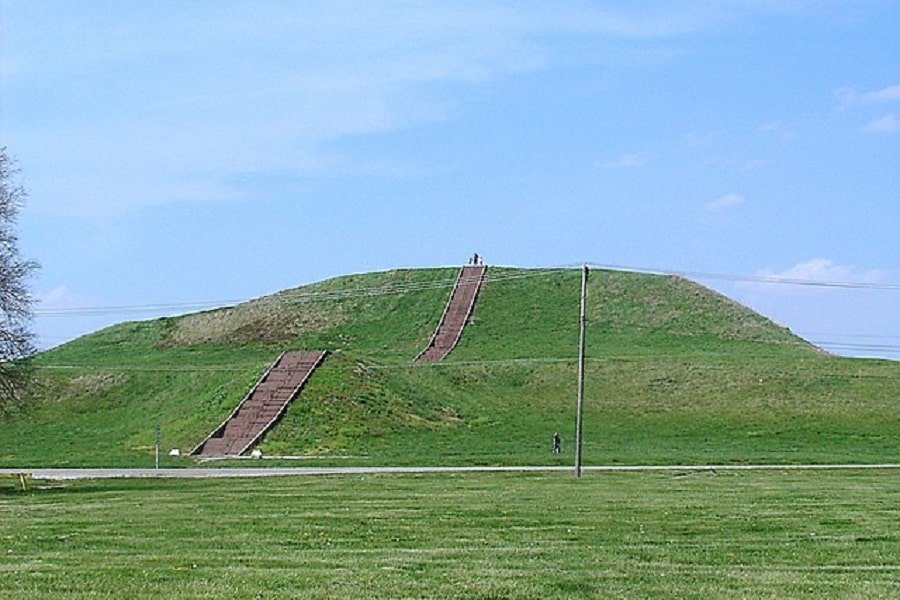
The continent of North America is made up of Canada and the United States of America. Across the continent, several noteworthy pyramids have been discovered. Many of these are ceremonial mounds with religious significance. Otherwise, mounds were constructed to honor the dead, having been a part of more elaborate funerary practices.
Throughout North America, Native American cultures built pyramidal platform mounds. Platform mounds are normally constructed with the intention of supporting a structure. While not all mounds were pyramidal platforms, the tallest pyramid structure in North America, Monk’s Mound, certainly was.
The Mound was originally terraced, with a rectangular building situated at the top. Found in Cahokia, a significant pyramid city in modern-day Illinois, Monk’s Mound was constructed between 900 and 1200 CE. Most pyramids in North America were constructed with layers of shaped, compacted soil.
Construction would span only a handful of months for basic structures. Other, more complex pyramids would require more time as they would be using materials other than soil. The construction of cairns would also take some time, depending on the size of the rocks used.
Pyramids in Canada
Although not as famed as the Great Pyramid of Giza, there are pyramid-like structures in Canada. These pyramids on British Columbia’s Harrison Hill are the Scowlitz Mounds. Alternatively, the site is called the Fraser Valley Pyramids, named for their proximity to the Fraser River.
The Scowlitz Mounds have 198 identified pyramids or ancestor mounds. They date to about 950 CE (1000 Before Present) and originate from the Sq’éwlets (Scowlitz) First Nation, a Coastal Salish people. Excavations have discovered that the dead were buried with copper ornaments, abalone, shells, and blankets. According to Sq’éwlets, a clay floor was laid prior to burial and a stone wall would be constructed.
Burial practices amongst the Coast Salish vary from tribe to tribe. While ancestor mounds were made by some, others took to erect above-ground tombs or funerary petroforms.
Pyramids in the United States
Yes, there are pyramids in the United States, and not just the Bass Pro Shop megastore pyramid in Memphis, Tennessee. Scrub Las Vegas’ Luxor from your mind, too. We’re talking about real, historical pyramids here.
Pyramids in the United States may not look like their counterparts in the rest of the Americas, but they’re pyramids all the same. The most famous pyramid structures in the United States are mounds, credited to cultures collectively identified as “Mound Builders” by historians. The mounds could have been created for burial purposes or, like Monk’s Mound, for civic duties.
The most famous pyramid in the United States is located at the archaeological site, Cahokia. Home to Monk’s Mound, Cahokia was an extensive settlement during its heyday a thousand years before Europeans stumbled across the American continent.
Cahokia’s overwhelming success in trade and manufacturing meant that the ancient city grew to an impressive 15,000 population. Recently, the Cahokia Mounds Museum Society has put forth an AR (augmented reality) project to reflect how Cahokia may have looked during its peak.
READ MORE: How Old Is the United States of America?

Mounds in Mississippian Culture: Different-Looking Pyramids
Mississippian culture refers to the Native American civilizations that flourished between 800 CE and 1600 CE in the Midwestern, Eastern, and Southeastern United States. Mounds in these cultures were largely ceremonial. They were – and are still considered – sacred. The oldest mound identified dates back to 3500 BCE.
Unfortunately, mounds as they pertain to Mississippian culture, along with numerous other sacred indigenous sites, have been threatened in the past. Many are mistaken as natural hills or mounds, rather than man-made wonders. It is up to modern man to preserve these ancient sites and their rich history.
Pyramids in Central America
Tallest Pyramid: Pyramid of La Danta (236.2 feet) at El Mirador/El Petén, Guatemala
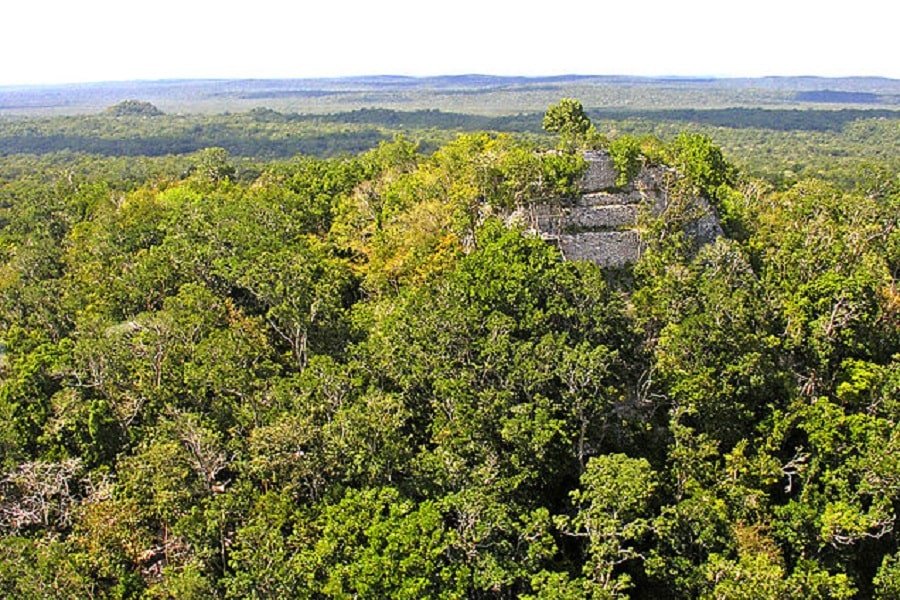
Some of the most well-known pyramids in America are found in Central America, more specifically Mesoamerica, which is a region that stretches from southern Mexico to Northern Costa Rica.
These pyramids were built from as early as 1000 BC, up until the Spanish conquest sometime in the 16th century. The pyramids from this time are fashioned as ziggurats with many steps and terraces, and they were either built or used by the many cultures living in the region, such as the Aztecs and Mayans.
Throughout Central and South America, Talud-Tablero architecture reigned supreme. Talud-Tablero architectural style was used during temple and pyramid construction throughout Pre-Columbian Mesoamerica, especially the Early Classic Period of Teotihuacan.
Also known as the slope-and-panel style, Talud-Tablero was common throughout Mesoamerica. A great example of this architectural style is the Great Pyramid of Cholula.
Oftentimes located within a pyramid city, pyramids in Central America acted as both monuments to the Incas and Aztec gods and burial sites for deceased kings. They were viewed as sacred sites where religious ceremonies would take place. From votive offerings to human sacrifice, the steps of Mesoamerican pyramids saw it all.
READ MORE: Aztec Religion
Mayan Pyramids
The tallest known pyramid in Central America can be found in today’s Guatemala. Known as the Pyramid of La Danta, this ziggurat is notable for its massive size and implied importance to the ancient Mayans. It would have been one of several pyramids located in the Mayan city, El Mirador.
Some important Mayan Pyramids include:
Temple of the Feathered Serpent at Chitzen Itza, Mexico

Temple of the Feathered Serpent, also called El Castillo, the Temple of Kukulcán, and Kukulcán is a Mesoamerican pyramid that looms at the center of Chichén Itzá, an archaeological site in the Mexican state of Yucatan.
The temple was built somewhere between the 8th and 12th centuries by the pre-Columbian Maya civilization and is dedicated to the Feathered Serpent deity Kukulcán, closely related to Quetzalcoatl, another Feathered-Serpent deity of ancient Mesoamerican culture.
It is a step pyramid roughly 100 feet high with stone stairways on all four sides that rise at a 45° angle to a small structure on top. There are approximately 91 steps on each side, which when added to the number of stairs of the temple platform on top makes a total of 365 steps. This number equals the number of days of the Mayan year. Besides this, there are sculptures of feathered serpents running down the sides of the balustrade facing North.
The ancient Mayans had an impressive knowledge of astronomy as the pyramid is laid out in a such way that on the spring and autumn equinoxes, a series of triangular shadows are cast against the northwest balustrade, which gives the illusion of a great plummeted serpent slithering down the staircase of the temple.
Another interesting thing about this pyramid is its ability to produce unique sounds when you clap your hands around it which resemble the chirping of a Quetzal bird.
Tikal Temples
The ruins of Tikal city were once a ceremonial center of the ancient Maya civilization. It is one of the largest archaeological sites and was the largest urban center in the southern Maya lands. It is located in the northern part of the region of the Petén Basin, Guatemala, in a tropical rainforest. The site was declared a UNESCO World Heritage site and is a central attraction of Tikal National Park.
Tikal used to be a small village in the Middle Formative Period (900–300 BCE) and became an important ceremonial center with pyramids and temples in the Late Formative Period (300 BCE–100 CE). Its greatest pyramids, plazas, and palaces, however, were constructed in the Late Classic Period (600–900 CE).
The major structures of the site are several pyramidal temples and three large complexes, known as an acropolis.
Temple I, called the Temple of the great Jaguar, is situated in the middle of Tikal National Park. It is 154 feet high and was built during the life of Ah Cacao (Lord Chocolate), also known as Jasaw Chan K’awiil I (AD 682–734), one of Tikal’s greatest rulers, who is also buried here.
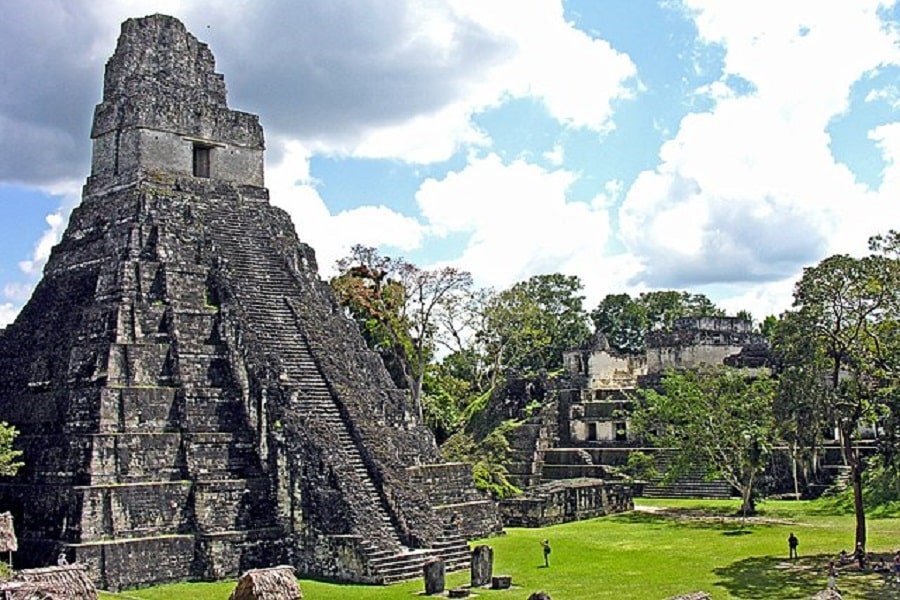
Temple II, the Temple of the Masks, is 124 feet high and was built by the same ruler as the previous temple in honor of his wife, Lady Kalajuun Une’ Mo’.
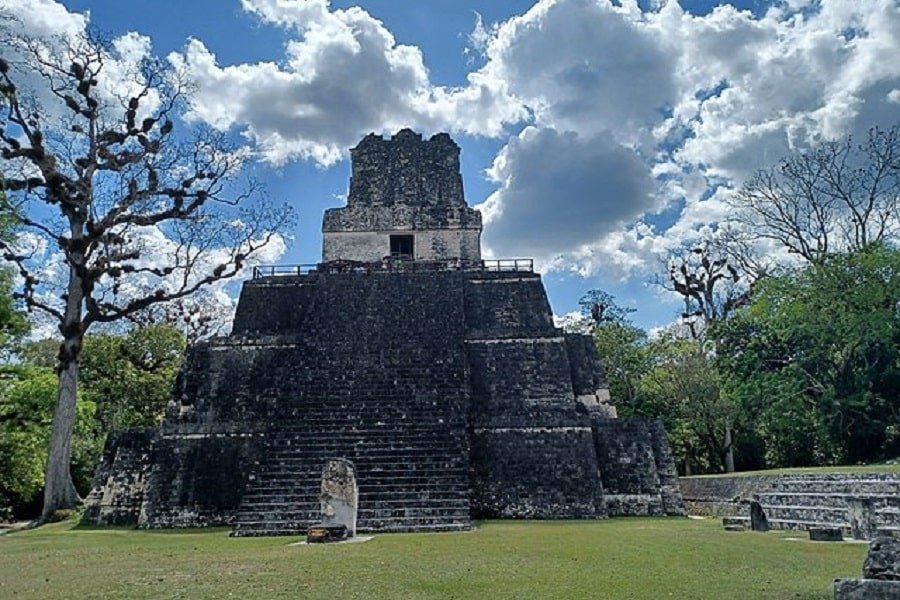
Temple III, the Temple of the Jaguar Priest, was built around 810 AD. It is 180 feet high and is probably the resting place of King Dark Sun.
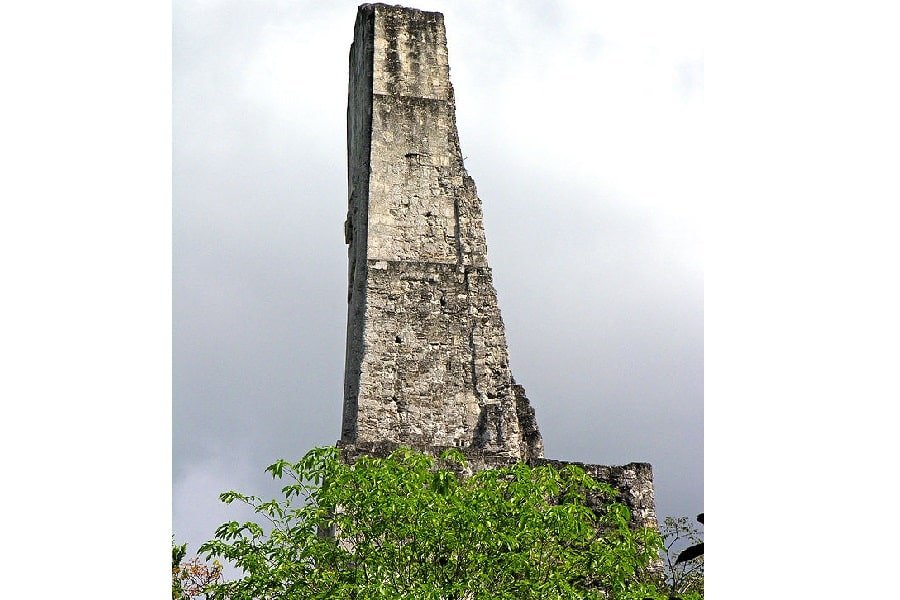
Temple IV is thought to be the tallest structure built by the ancient Maya, with a height of 213 feet, while Temple V is the second-highest structure in Tikal and stands 187 feet high.
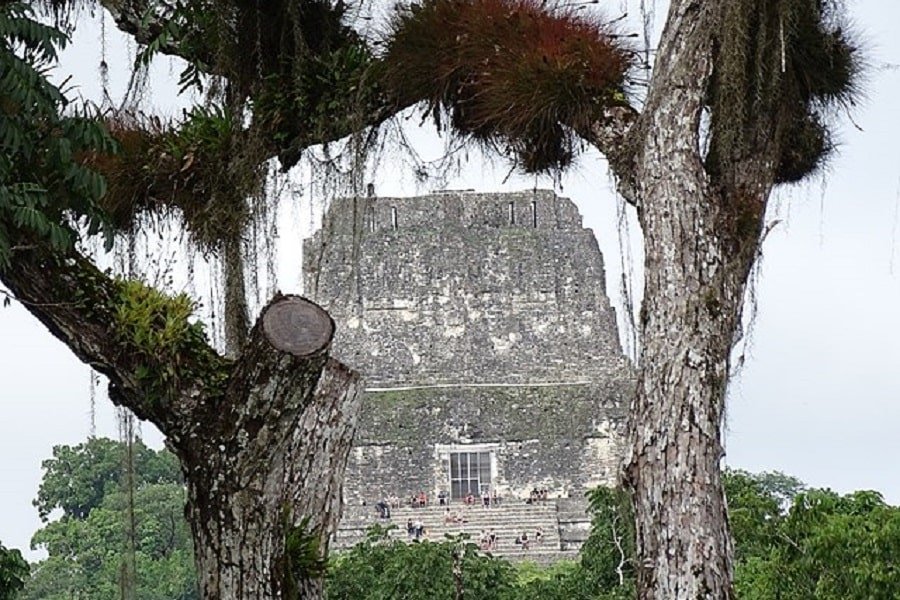
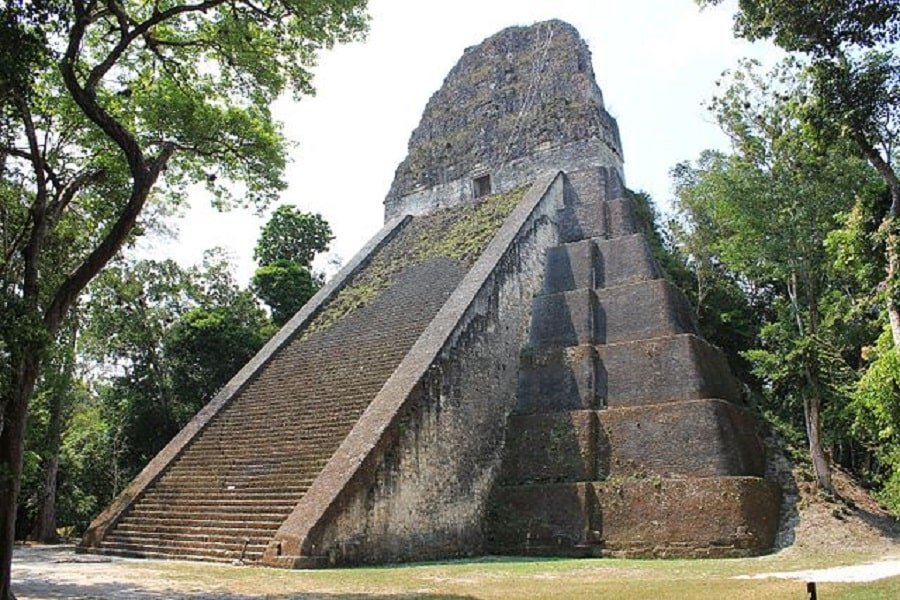
Temple VI, called the Temple of the Inscriptions, was built in AD 766 and is known for its 39 feet high roof-comb whose sides and the back are covered in hieroglyphs.
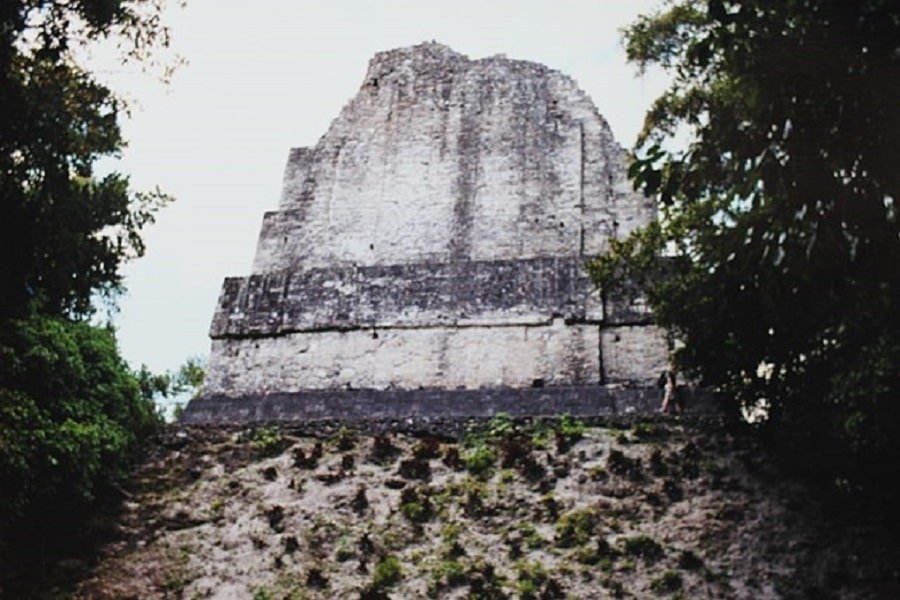
Apart from these temples, there are many other structures in the Tikal National park, but most are still underground.
La Danta

La Danta is one of the world’s largest structures. It is located in El Mirador, an ancient Mayan city, which is home to thirty-five triadic structures, including La Danta, made up of massive platforms topped with a series of three summit pyramids. The largest of these structures are La Danta and El Tigre, with a height of 180 feet.
La Danta is by far the most impressive and mysterious of them all,
standing a staggering 236 feet tall. With a volume of nearly 99 million cubic feet, it is one of the world’s largest pyramids, even larger than the Great Pyramid of Giza. It’s been estimated that 15 million man-days of labor were needed to construct a pyramid of such gigantic size. It remains a true mystery how the ancient Mayans built such a massive pyramid without pack animals such as oxen, horses, or mules and without using technologies such as the wheel.
It is believed that La Danta served religious purposes as many other similar Maya structures. Although there are thousands of structures in this Prehispanic city, none of them is as impressive as the La Danta temple.
Aztec Pyramids
Aztec pyramids are some of the oldest pyramids in America. But the tricky part about Aztec pyramids is that many of them were not actually built by the Aztec people. Instead, they were built by older Mesoamerican cultures and then used by the Aztec people.
A great example of this is the Great Pyramid of Cholula (Tlachihualtepetl). It was used by the Aztecs after its initial construction by the semi-legendary Toltecs. Tlachihualtepetl became a significant temple to the god Quetzalcoatl until Spanish contact. When Spanish conquistadors in the 16th century destroyed Cholula, they built a church atop the pyramid.
It remains one of the largest pyramids in the world.
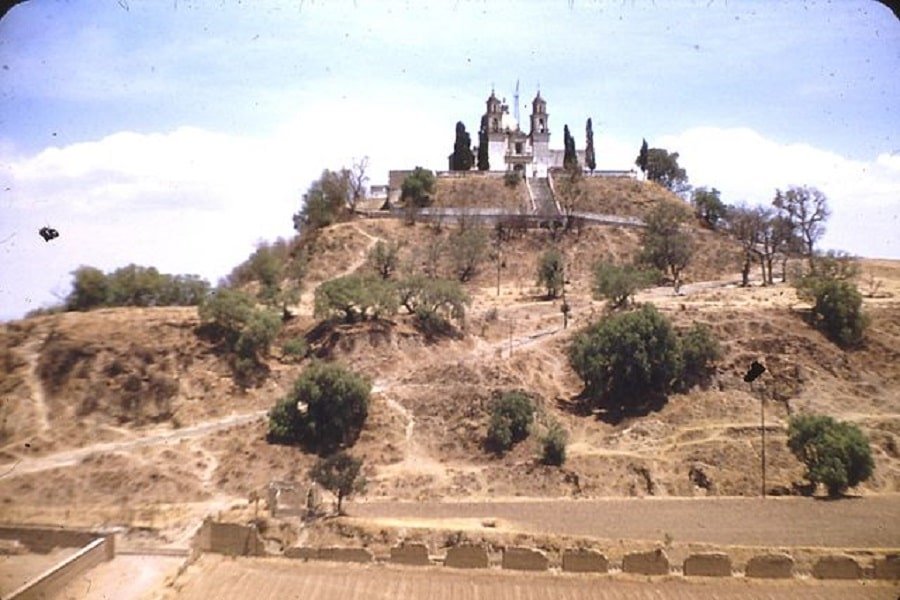
Other important pyramids built by others and used by the Aztecs include:
Pyramids of the Sun and Moon in Teotihuacan
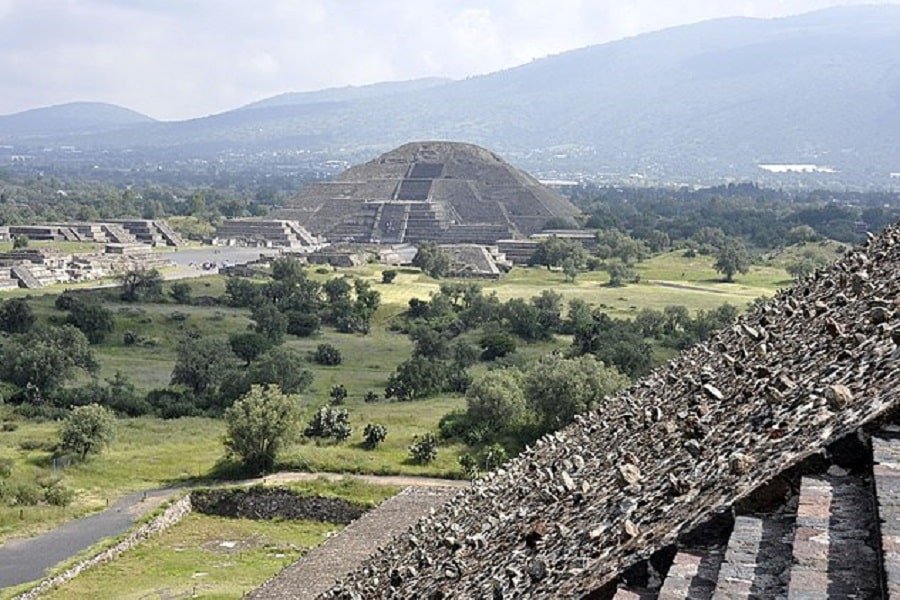
The Pyramids of the Sun and Moon are the largest and most significant structures in Teotihuacan, an ancient Mesoamerican city located in a sub-valley of the Valley of Mexico.
The pyramids were built over the earlier structures, and it is believed that the tombs of some of the Teotihuacan rulers can be found within their stone walls.
The pyramid of the Sun was built about 200 AD and is one of the largest structures of its type. It is around 216 feet high and measures approximately 720 by 760 at its base. Little is known of the people who built Teotihuacán, and the Pyramid of the Sun and what was its purpose. In the early 1970s excavations, a system of caves and tunnel chambers were discovered under the pyramid. Other tunnels were later found throughout the city.
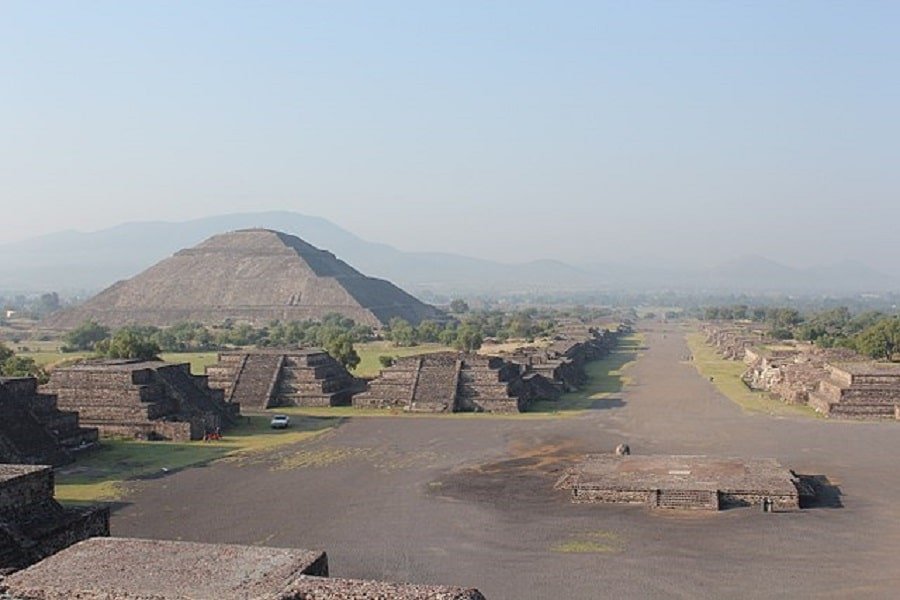
The Pyramid of the Moon, situated at the northern end of the Street of the Dead, was completed around 250 AD, and it covers an older structure. The pyramid was built in seven stages, with one pyramid being covered by another pyramid built on top until it finally reached its current size. The pyramid was probably used for ritual human and animal sacrifices and as a burial ground for sacrificial victims.

Templo Mayor
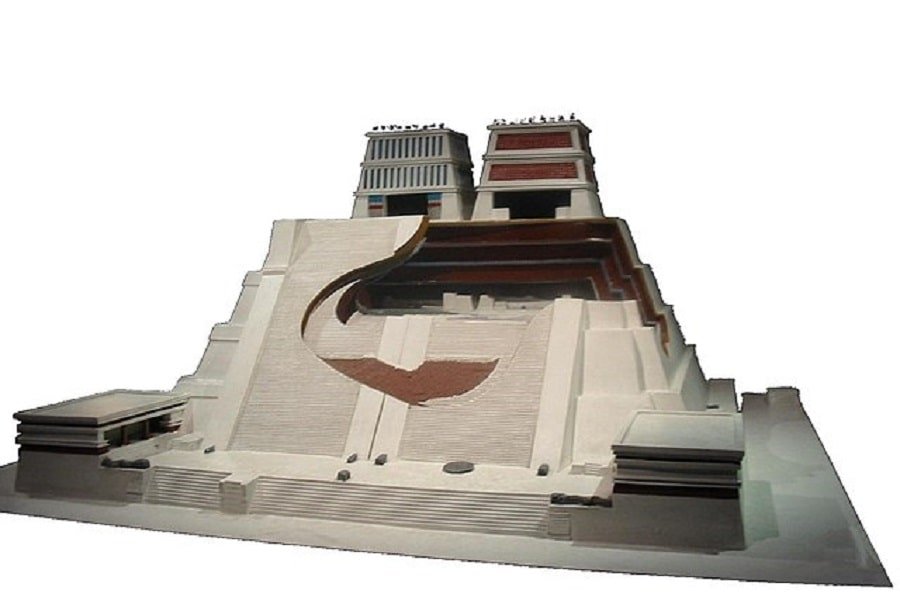
The Templo Mayor was the main temple, located in the center of Tenochtitlan, the capital city of the mighty Aztec empire. The structure was about 90 feet high and consisted of two stepped pyramids standing side by side on a huge platform.
The pyramids symbolized two sacred mountains. One on the left stood for Tonacatepetl, the Hill of Sustenance, whose patron was the god of rain and agriculture, Tlaloc. The one on the right represented the Hill of Coatepec and the Aztec god of war, Huitzilopochtli. Each of these pyramids had a shrine at the top dedicated to these important deities with separate staircases leading to them. The central spire was devoted to Quetzalcoatl, the god of wind.
The construction of the first temple began sometime after 1325. It was rebuilt six times and was destroyed by the Spanish in 1521. Later the Mexico City cathedral was built in its place.
Tenayuca
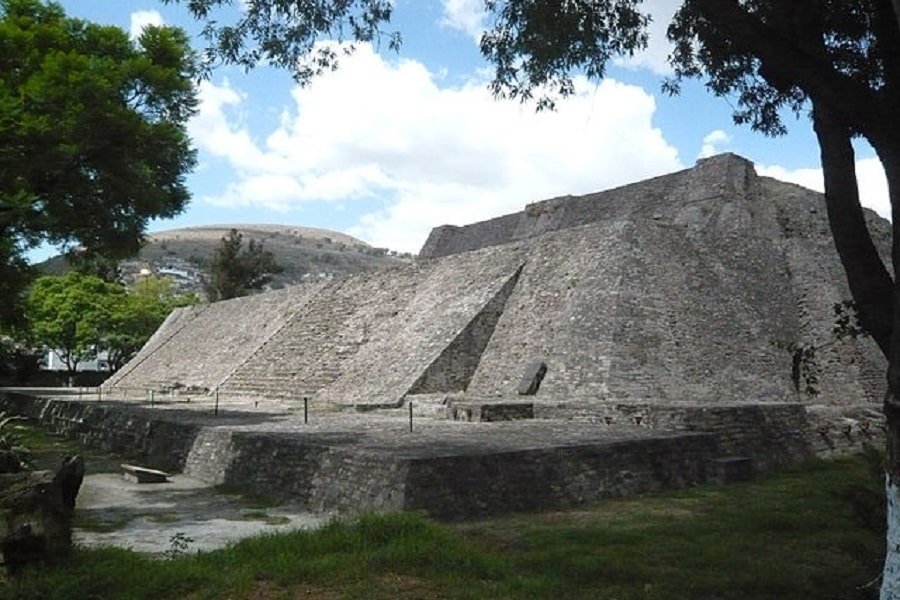
Tenayuca is a pre-Columbian Mesoamerican archaeological site located in the Valley of Mexico. It is considered the earliest capital city of the Chichimec, nomadic tribes who migrated, settled in the Valley of Mexico, and formed their empire there.
The pyramid was most likely built by Hñañu and Otomí, often referred to as Chichimeca, which is a pejorative Nahuatl term. Some remains indicate that the site was occupied as early as the Classic Period, but its population increased in the early Post-classic and continued to expand after the fall of Tula.
Tenochtitlan conquered the city around 1434, and it fell under Aztec control.
Tenayuca is the earliest example of the Aztec double pyramid and, like lots of other similar temple sites, Tenayuca was built in several phases with constructions built one atop the other. The serpent sculptures on the site are associated with sun and fire deities.
Mesoamerican Pyramids vs. Egyptian Pyramids: What’s the Difference?
In case you haven’t realized, American pyramids are nothing like Egyptian pyramids. Though, is anyone shocked? They are located, quite literally, on opposite sides of the world from one another. It’s only natural that their pyramids will be different!
Let’s quickly review what differentiates Mesoamerican and Egyptian pyramids. For starters, Egyptian pyramids are way older. The oldest known pyramid in the world is the Pyramid of Djoser in Egypt, which dates back to the 27th century BCE (2700 – 2601 BCE). Comparatively, the oldest pyramid in the Americas is thought to be the La Venta pyramid (394-30 BCE) in the Mexican state of Tabasco.
READ MORE: Ancient Egypt Timeline
Size
Continuing, the pyramids of Mesoamerica were built on a smaller scale than those in Egypt. They aren’t nearly as tall, but they tend to have more total volume and are much steeper. Egypt takes the cake for the tallest pyramid, though it’s the Great Pyramid of Cholula that is considered the largest pyramid on the planet.
Design
Lastly, we can see the difference in the architecture itself. Whereas an Egyptian structure ends at a point and has smooth sides, an American pyramid doesn’t. Usually, an American pyramidal structure has four sides; these four sides are not only steep but also act as stairs. Also, you won’t find a pointy end: most American pyramids have flat temples at their pinnacle.
While we’re at it, there is no evidence whatsoever that early pyramid civilizations communicated with one another (let alone with alien life). By this, we mean that Egyptians didn’t travel to the Americas and teach locals how to build pyramids. Likewise, they didn’t travel to Australia, Asia, or anywhere else; however, they did communicate with regional neighbors who also built pyramids. Each culture had a unique approach to pyramid construction; it’s just some awesome human phenomenon.
READ MORE: Ancient Egypt Timeline: Predynastic Period Until the Persian Conquest
Pyramids in South America
Tallest Pyramid: Huaca Del Sol “Pyramid of the Sun” (135-405 feet) at Valle de Moche, Moche, Peru
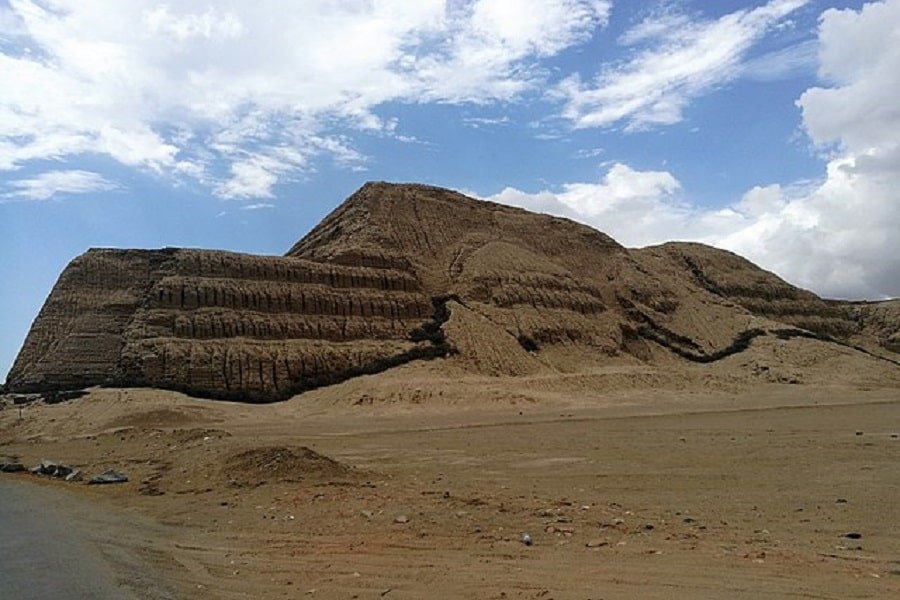
Pyramids in South America were built by the Norte Chico, Moche, and Chimu, as well as other Andean civilizations. Some of these civilizations, like the Caral, date back to 3200 BCE. Evidence also points to civilizations located in modern Brazil and Bolivia as having erected pyramidal monuments.
In Brazil, the largest country in South America, these structures were constructed over several generations with seashells by the Sambaqui Moundbuilders. Some experts even argue that Brazil had as many as one thousand pyramids at some point, though many had been destroyed after misidentifying them as natural hills.
Meanwhile, in the dense Amazon Rainforest, pyramids have been located by Lidar (Light Detection and Ranging) technology. Researchers have concluded that the settlement was left behind by members of the Casarabe culture 600 years ago. The city existed until roughly 100 years before Spanish explorers came to the New World.
The pyramids of South America do not share the same construction techniques as their northern neighbors. Brazil’s shell mounds aside, most pyramids in the southern continent are made from adobe clay brick. Roughly 130 million clay bricks were used to construct South America’s tallest pyramid, Huaca Del Sol. Its smaller counterpart, the temple Huaca Del Luna (alternatively known as the Pyramid of the Moon), was arguably just as impressive.
READ MORE: Ancient Civilizations Timeline: 16 Oldest Known Cultures From Around The World
Pyramids in Peru
The traces of human civilization in Peru date back to nomadic tribes that crossed to the Americas during the last Ice Age.
From the settling of these tribes to the Mochica and Nazca peoples in the first centuries AD and the famous Incas, we can trace the history back thanks to a large number of amazing archeological sites discovered throughout the country. While Machu Picchu is frequently mentioned, little is known about some other sites and pyramids in Peru, and they definitely deserve attention.
Huaca Pucllana
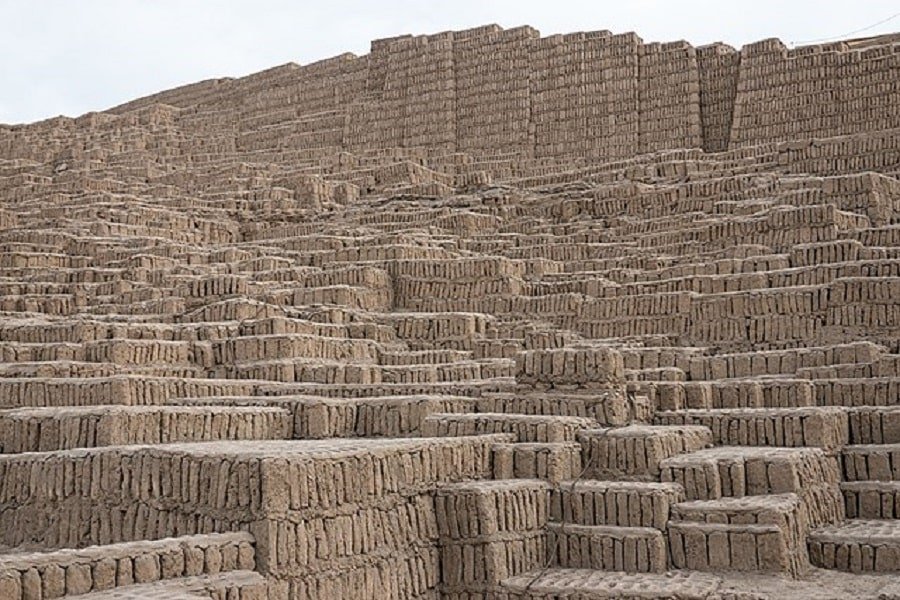
In the heart of the urban center of Lima sits Huaca Pucllana, a grandiose structure, built around 500 CE by the natives of Lima.
They built the pyramid at the height of their reign in the region using the unique method called the “library technique,” which consists of laying adobe bricks vertically with spaces in between. Such structure allowed this pyramid to absorb the tremors of earthquakes and withstand Lima’s seismic activities. Also, the walls of the pyramid are wider at the base than at the top due to the trapezoidal shapes, similar to the ones seen at Machu Picchu, which provided additional support.
Today the pyramid stands 82 feet tall, although archaeologists believe it was much larger. Unfortunately, during the last century, modern residents have built over some parts of the ancient ruins of Lima.
The Pyramids of Caral

If you travel some 75 miles north of Lima, you find yourself in Peru’s Barranca region near the central Peruvian coast, and you will stumble upon Caral and its majestic pyramids.
Caral is considered the oldest city in the Americas and among the oldest in the world. The pyramids of Caral were the central hub of the settlement and were built around 5000 years ago on the Supe Valley terrace, surrounded by desert. Therefore, they predate the pyramids of Egypt and the Inca pyramids.
The pyramids were made of stone and were likely used for city gatherings and celebrations. There are six pyramids in total, among which Piramide Mayor is the largest, rising 60 feet in height and measuring about 450 feet by 500 feet. Around them, archeologists have found numerous objects, including musical instruments, such as flutes made from animal bones.
The Pyramids of Cahuachi
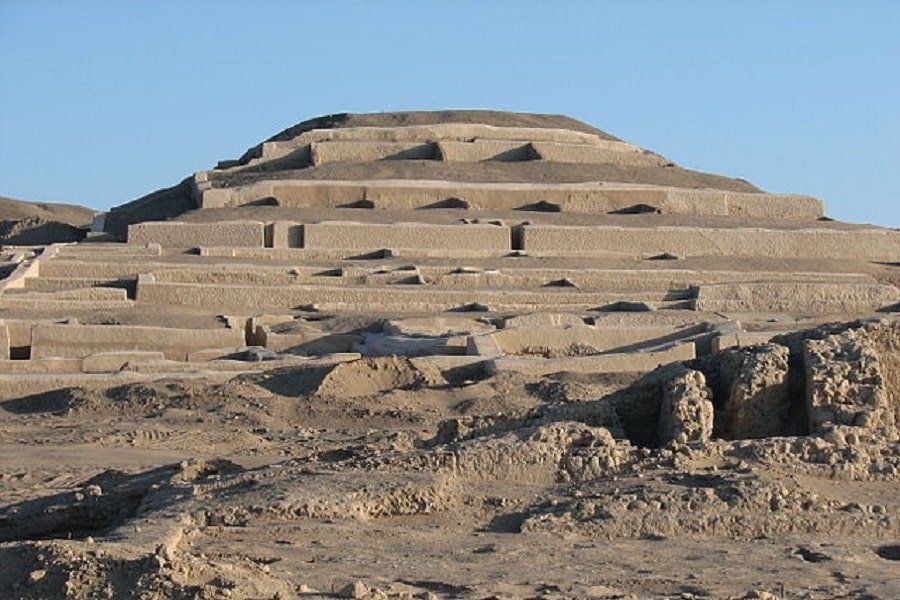
In 2008, several pyramids that extended over a 97,000-square-foot area were found under Cahuachi’s sands.
Cahuachi plays an important role in the history of the Nazca civilization and was built as a ceremonial center, with temples, pyramids, and plazas molded from the desert sand. The recent discovery revealed a central pyramid, measuring 300 by 328 feet at the base. It is asymmetrical and sits on four degraded terraces.
Those structures were used for rituals and sacrifices, as some twenty severed heads from offerings found inside one of the pyramids suggest. However, when the flood and a strong earthquake hit the Cahuachi, the Nazca left the region and their buildings.
Trujillo Pyramids
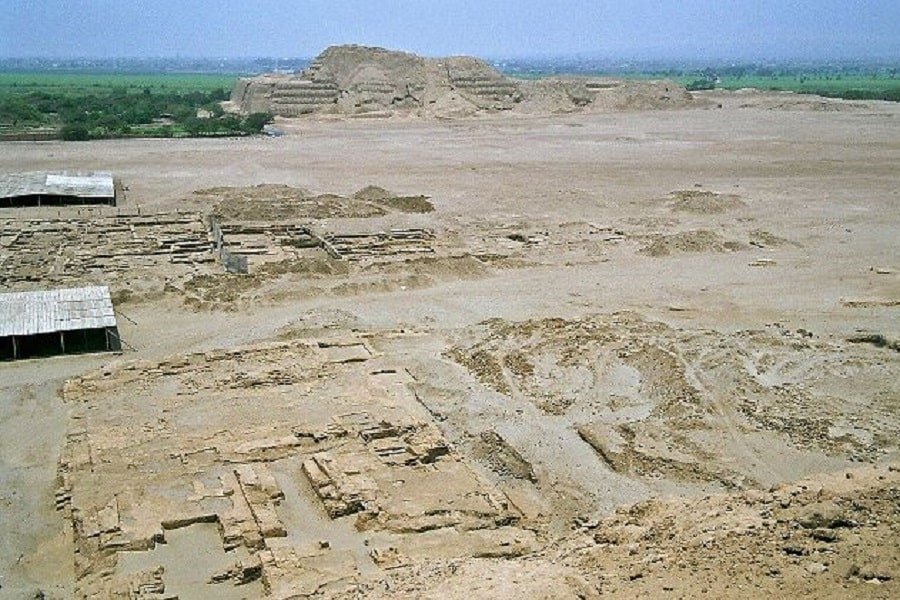
Trujillo is located in the north of Peru and is home to several important Inca sites, including the famous and enormous sun and moon pyramids (Huaca del Sol and Huaca de la Luna). These two pyramids served as temples and are believed to be the center of the Moche (or Mohica) culture (400 – 600 AD).
Huaca del Sol is considered the largest adobe structure in the Americas and was used as an administrative center. There is evidence of a dwelling and a large graveyard. The pyramid was built in eight stages, and what can be seen today is only 30% of the size of the pyramid in its original state.
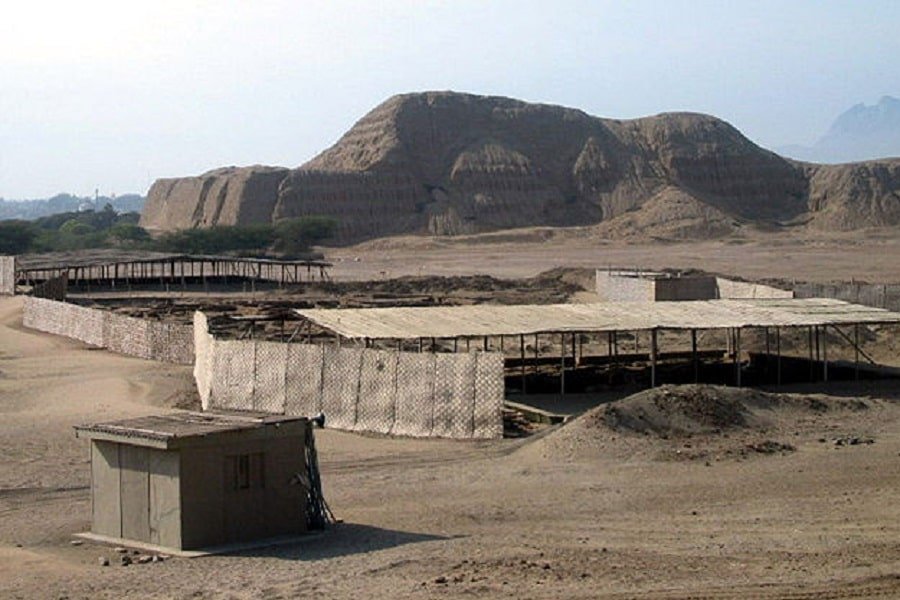
Huaca de la Luna is a large complex consisting of three main platforms and is known for its well-preserved friezes and depictions of the face of the god Ai-Apaec (god of life and death).
READ MORE: 10 Gods of Death and the Underworld From Around the World
Each of these platforms served a different function. While the northernmost platform, which used to be brightly decorated with murals and reliefs, has been destroyed by the looters, the central platform served as a burial site for the Moche religious elite. The eastern platform of black rock and adjacent patios was the site of human sacrifice. The remains of over 70 victims have been found here.
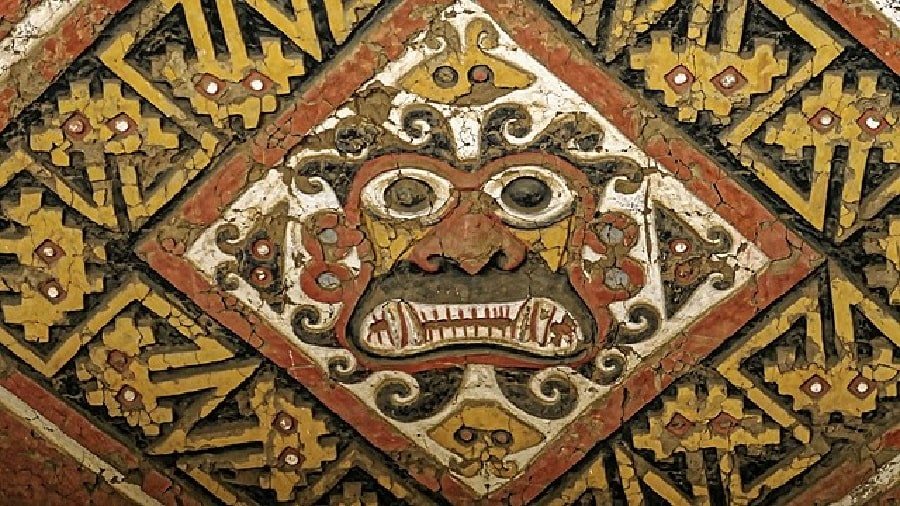
Pyramids in Brazil
The Pyramids of Brazil are located on the Atlantic Coast of southern Brazil. Some of them date back over 5000 years ago; they predate the Egyptian pyramids and are true wonders of the ancient world.
Although it’s not very clear what their purpose was, Brazilian pyramids were probably built for religious purposes. Some had structures on top of them.
Experts estimate that there were around 1000 pyramids in Brazil, but many were destroyed after being confused for natural hills or piles of trash or the purpose of building roads.
They were massive, and one such example is the structure located near the town of Jaguaruna, in the Brazilian state of Santa Catarina. It covers an area of 25 acres and is believed that its original height was 167 feet.
Pyramids in Bolivia
Shrouded in mystery, many ancient sites and pyramids can be found in Bolivia too. While some have been unearthed and explored, many are still hidden deep underground beneath the thick forests of the Amazon.
The Akapana Pyramid Mound
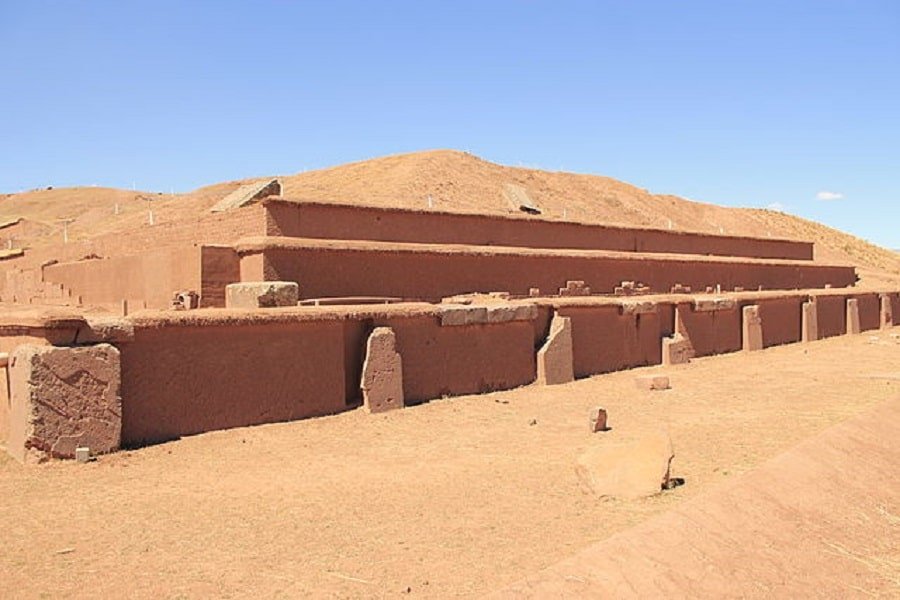
The Akapana pyramid at Tiahuanaco, home to some of the largest megalithic structures on Earth, is a 59 feet-high-step pyramid with a core made out of the soil. It is faced with massive, megalithic stones and resembles a large natural hill more than a pyramid.
A closer look reveals walls and columns at the base and carved stones on it. Although recent research showed that this pyramid was never finished in ancient times, its amorphous shape is the result of centuries of looting and using its stones for building colonial churches and a railway.
The Newly Discovered Underground Pyramid in Bolivia
Archaeologists have recently discovered a new pyramid in Bolivia, east of the Akapana pyramid.
Besides the pyramid, the special radar that has been used during the research has detected a number of other underground anomalies that might turn out to be monoliths.
It is unknown how old these ruins are, but some evidence suggests that they might date to 14,000 years B.C.
Pyramid Cities in America
A pyramid city is the term scholars use to describe the municipality that surrounds a specific pyramid. In some cases, there are multiple pyramids in a single city. Unlike Egyptian pyramid cities where much of the populace are priests and other holy figures, an American pyramid city was a bit more inclusive.
More often than not, a pyramid city would be a metropolis. The largest pyramid would be in the center of the ancient city, with other buildings extending outwards. There would be homes for citizens, markets, and other sites of religious importance elsewhere.
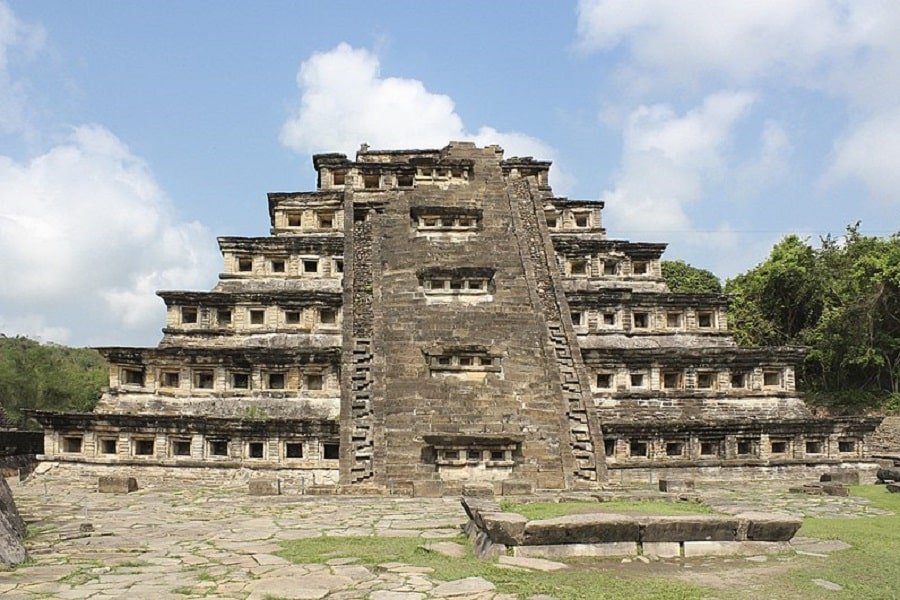
Why Are There Pyramids in America?
Pyramids were built in the Americas for so many reasons, we can’t list them all. For the cultures and civilizations that erected them, each pyramid had a unique meaning. Whereas one would be a temple, another would be a burial site. Though we can’t give a specific “why” as to the construction of American pyramids, we can get a general idea.
In all, American pyramids were built for 3 main reasons:
- Veneration of the dead, particularly important members of society
- Homage to the gods (or a specific god of a pantheon)
- Civic duties and activities, both religious and secular
The pyramids of America have been around for well over a thousand years. When we consider the talent and ingenuity of those who built pyramids, these ancient monuments will continue to be around for thousands more. Although not all of them are still in use today, it is up to modern man to preserve these wonders of a bygone era.
Pyramids in America Today
When thinking of ancient pyramids, most people first think of Egypt, but far from the deserts of Egypt, quite a few pyramids can be found throughout the United States as well.
From the largest and most well-known Monks Mound in North America to the impressive La Danta in Central America and the Akapana pyramid in South America, these majestic structures tell the stories of ancient times and the peoples who occupied them. They stand there withstanding the passage of time and entice and intrigue visitors from all around the world.
While many have been destroyed, or are still hidden underground and are yet to be found, a few have survived to the present day and are open for tours.
I wonder why we are not taught anything about the American pyramids when they are the oldest and most plentiful